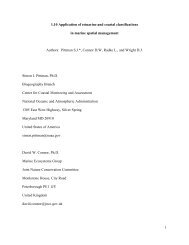Seamounts, Ridges, and Reef Habitats of American Samoa
Seamounts, Ridges, and Reef Habitats of American Samoa
Seamounts, Ridges, and Reef Habitats of American Samoa
- No tags were found...
You also want an ePaper? Increase the reach of your titles
YUMPU automatically turns print PDFs into web optimized ePapers that Google loves.
800Seafloor Geomorphology as Benthic Habitatf0045Figure 58.8 (A) BPI “zone” map <strong>of</strong> FBNMS, created from 1 m resolution multibeambathymetry data, with classifications based on the scheme <strong>of</strong> Lundblad et al. [37]. Dashedline shows smoothed track <strong>of</strong> Pisces V Dive P5–649. (B) Classification <strong>of</strong> same FBNMSbathymetry into “structures,” with same submersible track overlain.p0115p0120p0125such as narrow depressions or grooves, narrows crests or ridges, local depressions/crests on plains, lateral mid-slope depressions or grooves, lateral mid-slope crests orridges, open slopes, shelves, <strong>and</strong> broad flats [37]. Zone <strong>and</strong> structure classifications<strong>of</strong> Taema Bank (Figure 58.7) are based on the scheme <strong>of</strong> Lundblad et al. [37] for<strong>American</strong> <strong>Samoa</strong>.Taema Bank is made up <strong>of</strong> mostly flats <strong>and</strong> slopes in terms <strong>of</strong> zones, but there arevery distinct crests <strong>and</strong> depressions throughout (Figure 58.7A). Open slopes surroundthe crests <strong>of</strong> the bank along with the broad flats. As the shelf reaches an escarpmentnear a series <strong>of</strong> broad flats, there is also a series <strong>of</strong> spurs <strong>and</strong> grooves. These pervasivefeatures are given structure classifications <strong>of</strong> narrow crests, lateral mid-slope depressions,<strong>and</strong> lateral mid-slope crests (Figure 58.7B). The open slopes lead down to broaddepressions with open bottoms on both sides <strong>of</strong> Taema Bank. Submersible observationson Dives P5–648 <strong>and</strong> P5–650 visually confirmed these classifications <strong>and</strong> noted thatthe shelf contains stretches <strong>of</strong> colonized pavement covered with a veneer <strong>of</strong> s<strong>and</strong> [41].Within the fringing lateral mid-slope depressions <strong>and</strong> crests on the open slopes are colonizedpavement <strong>and</strong> hummocky bottom with low relief <strong>and</strong> ~5% s<strong>and</strong> cover.Fagatele Bay <strong>and</strong> Canyon: Fagatele Bay (Figures 58.6 <strong>and</strong> 58.8), <strong>and</strong> its continuationdeeper <strong>of</strong>fshore as a canyon, is the result <strong>of</strong> an ancient caldera that collapsed<strong>and</strong> subsided, causing the seaward rim to be breached by the ocean <strong>and</strong> flooded [38].The fringing coral reef is indeed <strong>of</strong> continuing interest <strong>and</strong> concern in this US federalmarine sanctuary that has essentially recovered from a near-devastating infestation<strong>of</strong> crown-<strong>of</strong>-thorns starfish in the late 1970s [42]. The bay was also affected byhurricanes in 1990, 1991, 2004, <strong>and</strong> 2005; <strong>and</strong> a coral bleaching event occurred in1994, possibly due to high sea-surface temperatures from an El Niño [43]. The livecoral cover has recovered well from near-total destruction, <strong>and</strong> populations <strong>of</strong> smallbenthic fish still thrive, particularly surgeonfish, damselfish, <strong>and</strong> angelfish [44,45].The submerged caldera that is Fagatele Bay dramatically slopes downward intoa canyon (canyon has not yet been classified with regard to habitat). At around 20 m
















